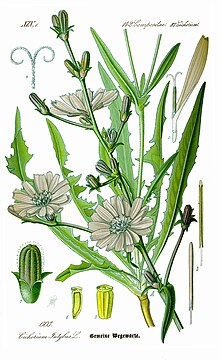
Back Sigorei Afrikaans Cichorium intybus AN هندباء برية Arabic هندباء بريه ARZ Cichorium intybus AST Adi kasnı Azerbaijani چیرتدیق AZB Быуын үләне Bashkir Trūkžuolė BAT-SMG Цыкорыя звычайная Byelorussian
| Common chicory | |
|---|---|

| |
| Blue-flowered form | |
| Scientific classification | |
| Kingdom: | Plantae |
| Clade: | Tracheophytes |
| Clade: | Angiosperms |
| Clade: | Eudicots |
| Clade: | Asterids |
| Order: | Asterales |
| Family: | Asteraceae |
| Genus: | Cichorium |
| Species: | C. intybus
|
| Binomial name | |
| Cichorium intybus | |
| Synonyms[1][2] | |
|
Synonymy
| |

Common chicory (Cichorium intybus)[3] is a somewhat woody, perennial herbaceous plant of the family Asteraceae, usually with bright blue flowers, rarely white or pink. Native to the Old World, it has been introduced to the Americas and Australia.[4]
Many varieties are cultivated for salad leaves, chicons (blanched buds), or roots (var. sativum), which are baked, ground, and used as a coffee substitute and food additive. In the 21st century, inulin, an extract from chicory root, has been used in food manufacturing as a sweetener and source of dietary fiber.[5] Chicory is also grown as a forage crop for livestock.[6]
- ^ "Cichorium intybus L. synonyms". Tropicos.org. Missouri Botanical Garden. Retrieved 23 March 2014.
- ^ "Cichorium intybus L." The Plant List. 2013. Retrieved 23 March 2014.
- ^ "Cichorium intybus". FAO - Food and Agriculture Organization of the UN. Archived from the original on 2013-05-23. Retrieved 2013-12-16.
- ^ "Cichorium intybus L." Plants of the World Online. Retrieved 18 February 2023.
- ^ Raninen, K; Lappi, J; Mykkänen, H; Poutanen, K (2011). "Dietary fiber type reflects physiological functionality: Comparison of grain fiber, inulin, and polydextrose". Nutrition Reviews. 69 (1): 9–21. doi:10.1111/j.1753-4887.2010.00358.x. PMID 21198631.
- ^ Blair, Robert (2011-04-30). Nutrition and Feeding of Organic Cattle. ISBN 978-1-84593-758-4.
© MMXXIII Rich X Search. We shall prevail. All rights reserved. Rich X Search